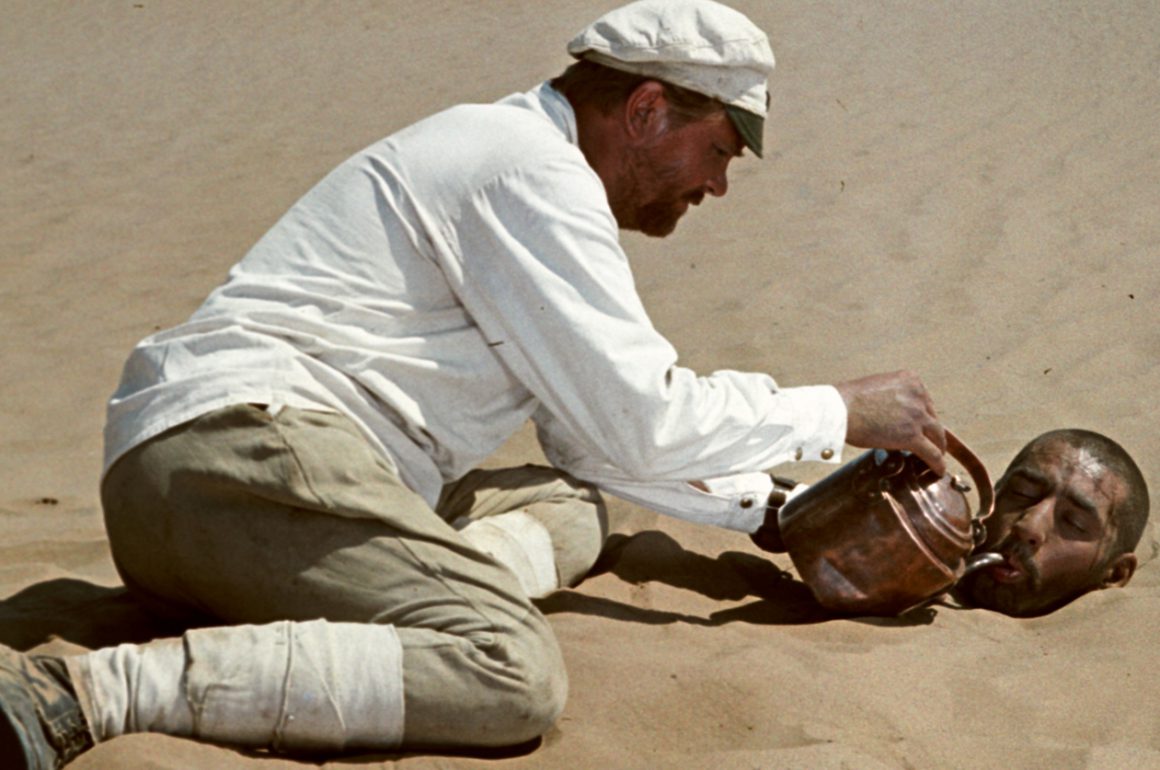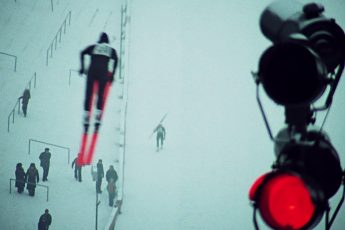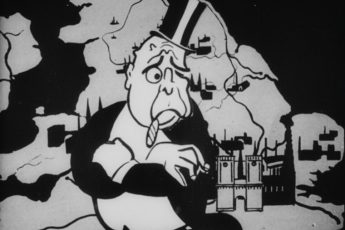Soviet Colonialism Through Film
Vladimir Motyl’s The White Sun of the Desert (Beloye solntse pustyni, 1970)
Vol. 104 (April 2020) by Isaac W. R. Miller
The White Sun of the Desert, a 1970 Soviet film directed by Vladimir Motyl and written by Valentin Yezhov and Rustam Ibragimbekov, takes place during the Russian Civil War. It tells the story of Fyodor Ivanovich Sukhov (played by Anatoly Kuznetsov), a Red Army soldier in what would become the Turkmen Soviet Socialist Republic – modern-day Turkmenistan. Through a twist of fate, he is given responsibility over a harem, composed of the many wives of a Basmachi rebel leader named Abdullah (Kakhi Kavsadze). Sukhov’s efforts to protect and modernize the wives put him in conflict with Abdullah and the Basmachi. After a series of adventures, Sukhov is able to kill Abdullah, defeat his Basmachi forces, and liberate the harem of wives. This film became one of the most popular in Soviet history and is still widely watched and quoted in Russia today.1 This makes the film of interest to historians of the region, as widespread viewings undoubtedly influenced Russian ideas about Central Asia and its place within the Soviet Union. Through the film’s depiction of Central Asia and its inhabitants, The White Sun of the Desert conveys a rationale for Soviet colonialism. It portrays those who oppose Soviet (and thus Russian) domination as evil and cruel oppressors, the remaining Central Asians as comically backwards and in need of an outside force to liberate and modernize them, and the Russian characters as liberators.
The film is an example of the “Eastern” genre – the Soviet companion to the Westerns of Hollywood. Central Asia during the Russian Civil War was one of the most common settings for these Easterns – films such as The Thirteen (1937), The Bodyguard (1967), and The Seventh Bullet (1972) all share this backdrop. And, of course, in all of these films the predominantly Russian Red Army are the heroic modernizers, whereas the Central Asian Basmachi are the barbaric antagonists.
A Russian man rescuing a non-Russian woman from oppression is also not unique to The White Sands of the Desert. The 1967 comedy Kidnapping, Caucasian Style, shows a Russian protagonist among the people of the Caucasus, who are portrayed, like the Central Asians of the Eastern genre, as barbarous, backwards, or both. Admittedly, the formula in this film is slightly different: Nina (Natalya Varley), the Caucasian love interest, is portrayed as being modern and independent; while the Russian protagonist Shurik (Aleksandr Demyanenko) is heroic, but a bit of a buffoon. Still, the majority of the Caucasian characters are either villains or alcoholic caricatures written for comic relief. Shurik must rescue Nina from bridenapping and forced marriage, and in doing so he is shown as modernizing a region purportedly marked by violent and sexist backwardness.
In the White Sun of the Desert, much of the conceptualization of Central Asians is formed through the character of Abdullah. The primary antagonist in the film, he is the leader of a group of Basmachi rebels. The Basmachi were a Turkestani nationalist group who had fought for Central Asian liberation from the Russian Empire in the years prior to the Bolshevik Revolution, and continued their fight for freedom against the Empire’s Soviet inheritors.2 Although they were an organized group of national liberation fighters, the Russian characters in the film consistently refer to the Basmachi as bandits. The use of the word “bandit,” rather than, for example, “rebel,” allows the film to portray the Basmachi not as freedom fighters, but as disorganized criminal elements.
Abdullah himself is shown in the film to be a man of extraordinary cruelty. Before the start of the film, with the Red Army hot on his trail, Abdullah decides to shoot and kill his harem of wives so that no one else could have them. When he, as a prisoner of Sukhov’s, later reunites with his harem, he angrily admonishes them for not having committed suicide following their earlier abandonment. As the film progresses, Abdullah strangles the youngest of his wives, bayonets Petrukha (a young Red Army soldier played by Nikolai Godovikov), and attempts to blow up Sukhov and the remaining harem members.
Unlike the harem’s husband, the group of wives is not by nature violent; instead, they are consistently the victims. Throughout the film, they do nearly nothing besides stand around and follow the instructions of the various men, most prominently Sukhov. The harem never displays any fight or fire, and the consistent impression is that they are at the whim of their masters. In order for their dignity, their autonomy, and their lives to be preserved, they are in need of a leader and protector. That hero comes in the form of the Red Army. It is Bolsheviks that saved their lives at the film’s beginning, and it is Red Army soldier Sukhov that guides them through their transition into marital liberation. When Abdullah returns to wreak vengeance and reclaim his wives, it is Sukhov who must shepherd and protect them. This classic relationship of endangered woman and male rescuer provides the film with yet another rationale for Soviet colonialism. Bolshevik Russia appears to be needed by Central Asia to defeat its villains, liberate its oppressed peoples, and correct its backwardness.
Much has been written in recent years about Vladimir Putin’s desire to “restore” Russia to what is perceived as its rightful position as a “great power.”3 The very idea of “great powers” reveals a conceptualization of the international dynamics which is stratified and uneven. A great power cannot exist except in relation to powers which are not great, over which a great power can exert its power (in all of that power’s greatness). Putin’s overtures may appeal to a segment of the Russian population that sees itself as having once been dominant over its neighbors and deserving of a return to dominance. In other words, Putin’s rhetoric may appeal to those that believe that they should be Sukhov. In the film Sukhov is portrayed as commanding, yet compassionate; violent, yet only when called for. He vanquishes those who deserve to be vanquished and protects those who need protecting. He is dominant over the people of Central Asia, but in the film this dominance is justified.
There is a long history of such justification for Russian domination over Central Asia. Nikolai Sergeyevich Trubetzkoy, a Russian scholar, wrote in 1925 that Eurasia (a region defined by Trubetzkoy as comprising both Russia and the Central Asian steppe) “is a geographically, ethnographically, and economically integrated system whose political unification was historically inevitable.”4 He claimed that the Russian people, along with the various peoples of Central Asia and Siberia, formed a single contiguous unit, and that any perceived differences between the various peoples were simply gradual changes over the breadth of an extended family, rather than constituting evidence of any solid line of division. Based upon this assertion, the inclusion of Central Asia into the Soviet Union would have been entirely natural.
If we are to assume the inevitability of this union, then why was there armed Turkmeni resistance against the Soviet integration of Central Asia? Trubetzkoy stipulated that a powerful military force had been necessary to pacify the resisting elements and unite the steppe people as one. According to Trubetzkoy, that uniting force had once been Genghis Kahn; this time it was Russia.5 Trubetzkoy’s argument seems to mirror the one posed half a century later by The White Sun of the Desert. Sukhov and his Red Army comrades play the part of Russia-in-miniature, having come to Central Asia to unite it under Bolshevik authority. The violence and backward culture of the native people would benefit from the firm, modernizing hand of the Soviet Union, and so resistors such as Abdullah, from this perspective, must be removed in order to make way for the inevitable and mutually beneficial unification.
In the scholar Trubetzkoy’s eyes, this forced union did not represent colonization or hegemony by Soviet Russia, because, he claimed, the people of Central Asia were for the first time joining the Russians as equals. It was his stipulation that, under the rule of the tsars, non-Russians within the Empire were clearly subordinated to Russians, but that within the Soviet system, all people had equal ownership of and mastery over the state. Trubetzkoy acknowledged that Russians, due to their large population and long-standing tradition of participation in state government, should take a leadership role in the new Soviet Union; but he felt that Russians, for the first time, were “no longer masters among household members; only first among equals.”6 This duality, which holds Russians as both leaders of and equals to the Central Asian people, is admirable in sentiment, but seems a difficult line to tread in reality. Applied to the larger Soviet system, this would seem to result in a strange and confusing pattern, with all Soviet peoples getting an equal say in the workings of the government, but Russians somehow getting a larger equal say. Perhaps it is assumed that, while non-Russians such as Central Asians could voice dissenting opinions in a Russian-led governance, they should not do so, as the Russians generally know best.
Russia’s relationship with the other Soviet peoples, and especially with Central Asia, has been a longstanding area of scholarly focus and debate. Some have emphasized the multiethnic nature of the Soviet Union.7 Others, like Douglas Northrop, have argued that the Soviet Union was decidedly a Russian colonial empire.8 Still others have disputed this categorization, citing the vast differences between the internal structure of the Soviet Union and the dynamics at work between empires like Great Britain and her overseas colonies.9 Kevork K. Oskanian attempted to solve this issue by defining Russia’s unique approach to imperialism – hierarchy justified by the ability to “civilize” its neighbors, from whom Russia is not entirely distinct, sharing with them a history, some cultural elements, and an interconnected Eurasian space. Oskanian called this specific imperialist attitude Russia’s “hybrid exceptionalism.”10 While he does not mention Trubetzkoy in his work, it feels as though Oskanian is explicitly describing Trubetzkoy’s “first among equals” rationale for Russian leadership.11
If we want to find a “first among equals” dynamic in The White Sun of the Desert, we must turn our attention back to Sukhov and the harem. The Red Army soldier tells the harem that the Soviet system has liberated them, and that they are now free to act autonomously in pursuit of happiness. When they refer to him as “master,” he claims that he is not their master, but rather their equal, and instructs them to call him, simply, “Comrade Sukhov.” He claims that he will also refer to them as “comrade.” To the viewer, it may appear that Sukhov is one among equals, yet as he possesses experience and capabilities related to the trials ahead (combat with the Basmachi), he rightfully takes a position of leadership. As he guides them through the desert, occasionally calling roll and doling out instructions, his position within their family, to use Trubetzkoy’s metaphor of a household, can be said to not be that the of ruling parent or commanding spouse, but rather of the eldest child: the most capable and respected member of a contiguous unit.
Yet Sukhov’s metaphoric status as the harem’s big brother quickly leads to some questionable uses of his control. We see some initial inkling of the absoluteness of his power when Sukhov’s roll call ends with a missing harem member, Gyulchatai (played by two actresses: Tatiana Fedotova and Tatiana Denisova). Gyulchatai’s name is called once, and when she is found not to be standing uniformly with the remainder of the harem (she is distracted by playing with a turtle), Sukhov forcefully repeats himself. A note of anger in his voice brings Gyulchatai running to join the lineup of her fellow wives. This first assertion of Sukhov’s power over the harem is played for comedy in the film, but it also makes a statement about Sukhov’s relationship with the group of women. He operates here, not as an equal leader among willing followers, but instead as an absolute commander, who reacts with anger when even the minutiae of his control are questioned.
This assertive calling of roll is only a precursor to more liberal uses of Sukhov’s position of power. He later suggests to Gyulchatai that he might marry her off to the young Red Army soldier Petrukha. This suggestion that Sukhov holds control over the matrimonial fates of the harem women displays a level of authority which reaches far past that of a leader amongst equals. Control over the marriage of a woman is the traditional power of a parent, so, in asserting that control, we see that Sukhov operates not as a big brother among siblings, but as the metaphoric household’s traditionalist authority, the father. Sukhov confirms this relationship when he refers to Petrukha as “daughter,” despite his earlier emphasis on the use of the term “comrade.” This relationship of power and subservience displays for the viewer an unequal relationship between Russia, represented by Sukhov, and Central Asia, represented by the harem.
The mechanics of this miniature Soviet Union, with the Russian Sukhov exerting authority over the Central Asian harem, and sweeping away opposition like Abdullah and the Basmachi, is inherently paternalistic. It assumes that, as a result of their backward and often violent nature, the Central Asians are better off following the command of the Russian among them, and it encourages the audience of The White Sun of the Desert to view the relationship between these two groups as rightfully unequal. Despite what was written by Trubetzkoy, greater power cannot be held by one member in a group of equals, for the differentiation which is created by the uneven distribution of power separates the whole into stratified pieces.
In a Soviet Union where Russians wield greater authority, they become distinct from their peers, and this separation combines with the distribution of power to create a relationship of colonialism rather than brotherhood. The White Sun of the Desert has experienced long-standing popularity and viewership in Russia, and through its depiction of Central Asian people and their position relative to Russians, the film has the potential to influence or even confirm the way in which the viewer sees Central Asians and their place in society; in plain terms, The White Sun of the Desert attempts to justify Russian and Soviet colonialism. The film is not unique in this – other Easterns and films like Kidnapping, Caucasian Style also further implicit arguments for Russian-led Soviet domination over non-Russian nationalities. The sustained popularity of The White Sun of the Desert and films like it is an indicator of a society which has not yet rid itself of that colonial viewpoint.
References
- 1.David Gillespie, “The Sounds of Music: Soundtrack and Song in Soviet Film,’’ Slavic Review, vol. 62, no. 3, 2003, 477-478.
- 2.Michael Rywkin, Moscow’s Muslim Challenge: Soviet Central Asia, Armonk, M. E. Sharpe, Inc., 1990, p. 43.
- 3.Cristian Nitoiu, “Aspirations to Great Power Status: Russia’s Path to Assertiveness in the International Arena under Putin,’’ Political Studies Review 15, no. 1 (2017): 39-48.
- 4.Nikolai Sergeyevich Trubetzkoy, The Legacy of Genghis Khan, Ann Arbor, Michigan Slavic Publications, 1991, p. 167.
- 5.Trubetzkoy, The Legacy of Genghis Khan, p. 167.
- 6.Trubetzkoy, The Legacy of Genghis Khan, p. 233.
- 7.See Rogers Brubaker, “Nationhood and the national question in the Soviet Union and post-Soviet Eurasia: An institutionalist account,’’ Theory and Society 23, no. 1 (February 1994): 47-78; Brubaker does, however, acknowledge the predominant status of the Russian nation within that multiethnic society.
- 8.Douglas Northrop, Veiled Empire: Gender & Power in Stalinist Central Asia (Ithica: Cornell University Press, 2004).
- 9.Adeeb Khalid, “Backwardness and the Quest for Civilization: Early Soviet Central Asia in Comparative Perspective,’’ Slavic Review 65, no. 2 (Summer, 2006): 231-251.
- 10.Kevork K. Oskanian, “A Very Ambiguous Empire: Russia’s Hybrid Exceptionalism,’’ Europe-Asia Studies 70, no. 1 (January 2018): 26-52.
- 11.For further reading, see Terry Martin, The Affirmative Action Empire: Nations and Nationalism in the Soviet Union, 1923-1939 (Ithaca: Cornell University Press, 2001); Martin traces the movement from early attempts at establishing a truly multiethnic state to Stalin’s eventual decision to return Russians to their previously held position as the leading nationality. For a history of nationality in the Tsarist Empire through the revolutionary period, see Andreas Kappeler, The Russian Empire: A Multiethnic History (London and New York: Routledge, 2013).




Leave a Comment